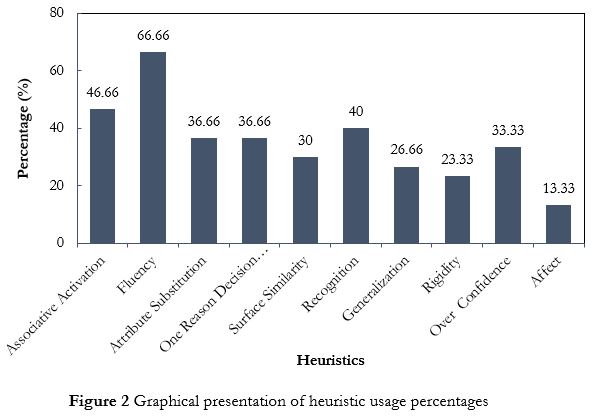
Analysis of Pre-Service Science Teachers’ Heuristic Reasoning Processes about Hydrogen Bonding
Abstract
Full Text:
DOWNLOAD PDFReferences
Akerlind, G. S. (2005). Variation and commonality in phenomenographic research methods. Higher Education Research & Development, 24(4), 321–334.
Barker, V., & Millar, R. (2000). Students’ reasoning about basic chemical thermodynamics and chemical bonding: what changes occur during a context-based post-16 chemistry course? International Journal of Science Education, 22(11), 1171– 1200.
Connor, P. E., & Becker, B. W. (2003). Personal value systems and decision-making styles of public managers. Public Personnel Management, 32(1), 155-180.
Connor, M.C., Finkenstaedt-Quinn, S.A., & Shultz, G.V. (2019). Constraints on organic chemistry students’ reasoning during IR and 1H NMR spectral interpretation. Chemistry Education Research and Practice, 20, 522-541.
Cooper, M. M., Corley, L. M., & Underwood, S. M. (2013). An investigation of college chemistry students’ understanding of structure-property relationships. Journal of Research in Science Teaching, 50(6), 699−721.
Cooper, M. M., Williams, L. C., & Underwood, S. M. (2015). Student understanding of intermolecular forces: a multimodal study. Journal of Chemical Education, 92(8), 1288–1298.
Didis N., Ozcan O., & Abak A. (2008). Quantum physics from students’ perspective: a qualitative study. Hacettepe Üniversitesi Eğitim Fakültesi Dergisi, 34, 86-94.
Duis, J. M. (2011). Organic chemistry educators’ perspectives on fundamental concepts and misconceptions: An exploratory study. Journal of Chemical Education, 88(3), 346–350.
Evans, J. S. B. T. (2008). Dual-processing accounts of reasoning, judgment, and social cognition. Annual Review of Psychology, 59, 255−278.
Evans, J. S. B. T., & Stanovich, K. E. (2013). Dual-process theories of higher cognition: advancing the debate. Perspectives on Psychological Science, 8, 223−241.
Ferrari, J. R., & Dovidio J. F. (2000). Examining behavioral processes in decision: decisional procrastination and decision-making style. Journal of Research in Personality, 34, 127–137.
Gigerenzer, G., & Goldstein, D. G. (1996). Reasoning the fast and frugal way: models of bounded rationality. Psychological Review, 103, 650−669.
Gilovich, T., Griffin, D., & Kahneman, D. (2002). Eds. Heuristics and Biases: The Psychology of Intuitive Judgment. Cambridge: Cambridge University Press.
Graulich, N. (2014). Intuitive judgments govern students’ answering patterns in multiple-choice exercises in organic chemistry. Journal of Chemical Education, 92, 205-211.
Graulich, N., Hopf, H., & Schreiner, P. R. (2011). Heuristic chemistry-addition reactions. Chemistry - A European Journal, 17, 30-40.
Graulich, N., Hopf, H., & Schreiner, P. R. (2011). Heuristic chemistry-elimination reactions. Chemistry - An Asian Journal, 6, 3180–3188.
Hastie, R. (2001). Problems for judgment and decision making. Annual Review of Psychology, 52, 653-683.
Henderleiter, J., Smart, R., Anderson, J., & Elian, O. (2001). How do organic chemistry students understand and apply hydrogen bonding? Journal of Chemical Education, 78, 1126-1130.
Maeyer, J., & Talanquer, V. (2013) Making predictions about chemical reactivity: assumptions and heuristics. J. Res. Sci. Teach. 50, 748−767.
Maeyer, J.R. (2013). Common-sense chemistry: the use of assumptions and heuristics in problem solving. PhD Thesis, Department of Chemistry and Biochemistry, The University of Arizona.
McClary, L. K., & Talanquer, V. (2011). Heuristic reasoning in chemistry: making decisions about acid strength. International Journal of Science Education, 33, 1433−1454.
Miller, K., & Kim, T. (2017). Examining student heuristic usage in a hydrogen bonding assessment. Biochemistry and Molecular Biology Education, 45(5), 411-416.
Pérez, J. R. B., Pérez, M. E. B, Calatayud M. L., García-Lopera R., Montesinos, J. V. S., & Gil, E. T. (2017). Student’s misconceptions on chemical bonding: a comparative study between high school and first year university students. Asian Journal of Education and e-Learning, 5(1), 1-15.
Schwarz, N. (2004). Metacognitive experiences in consumer judgment and decision making. Journal of Consumer Psychology, 14(4), 332-348.
Stanovich, K. E., & West, R. F. (2000). Individual differences in reasoning: implications for the rationality debate. Behavioral and Brain Sciences, 23(5), 645-726.
Taagepera, M., Arasasingham, R., Potter, F., Soroudi, A., & Lam, G. (2002). Following the development of the bonding concept using knowledge space theory. Journal of Chemical Education, 79, 756-762.
Talanquer, V. (2014). Chemistry education: ten heuristics to tame. Journal of Chemical Education, 91, 1091-1097.
Tan, K. C. D., & Treagust, D. F. (1999). Evaluating Students’ Understanding of Chemical Bonding. School Science Review, 81, 75–83.
Todd, P. M., & Gigerenzer, G. (2000). Précis of simple heuristics that make us smart. Behavioral Brain Sciences, 23(5), 727−741.
Ugras, M. (2018). Heuristic reasoning of pre-service science teachers in chemistry topics. Journal of Baltic Science Education, 17(2), 343-356.
Vekli, G. S. (2020). Examination of prospective science teachers’ levels of designing project directed to national support programs: A profile of Turkey. Journal of Science Learning, 3(2), 36-45.
Villafane, S. M., Bailey, C. P., Loertscher, J., Minderhout, V., & Lewis, J. E. (2011). Development and analysis of an instrument to assess student understanding of foundational concepts before biochemistry coursework. Biochemistry and Molecular Biology Education, 39(2), 102–109.
Wihlborg, M. (2004). Student nurses’ conceptions of internationalism in general and as an essential part of Swedish nurses’ education. Higher Education Research & Development, 23(4), 433-453.
DOI: https://doi.org/10.17509/jsl.v4i1.23737
Refbacks
- There are currently no refbacks.
Copyright (c) 2020 Gülen Önal Karakoyun, Erol Asiltürk

This work is licensed under a Creative Commons Attribution-ShareAlike 4.0 International License.


Jl. Dr. Setiabudhi 229 Bandung 40154, West Java, Indonesia











